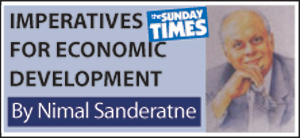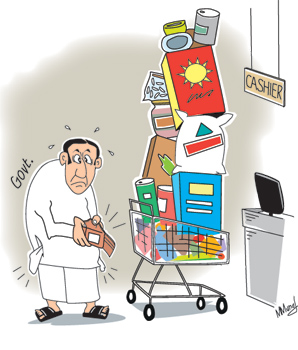Columns
Budget 2014: Containing fiscal deficit tough task
View(s):The preparation of a budget is a difficult task at the best of times. It is especially onerous this year as the economic background in which the 2014 budget is being drafted is by no means propitious.

Among the impediments to good fiscal management are the slowing down of the economy, reduction in exports and imports, high committed recurrent expenditure, political commitments to invest in large infrastructure projects, unwillingness to prune unnecessary and unproductive expenditure, continuing large losses in public enterprises and reluctance to reform public institutions.
The principal objective of the budget to bring down the fiscal deficit to 5.8 per cent can only be achieved if aggregate expenditure consisting of both government and private expenditure are contained.
Public views and suggestions
The Government has called for views and suggestions for the 2014 budget proposals. This is a good democratic practice and often elicits useful ideas in broad terms. However, most suggestions relate to advantages to the financial interests of the proponents, such as the reduction of taxes, exemption of profits of certain types of economic activities and enterprises. Broader comments, such as the curtailment of unproductive expenditures, reduction of losses in public enterprises and eliminating corruption that are very valid have no impact on the final budgetary outcome; only reiterated rhetoric of budget speeches.
Emerging fiscal situation
The emerging fiscal situation in the first four months of this year exemplifies these difficulties. The original revenue target by April in the Budget for 2013 was Rs. 365.2 billion. According to the Finance Ministry Mid-Year Fiscal Position Report, total revenue for the first four months of 2013 was Rs. 314 billion. While this was a deficit of Rs. 51 billion or 14 per cent in terms of the government’s revenue target, it is even less than the first four months of last year’s revenue collection by Rs. 12.6 billion.

In contrast, as has been the case for many years, there was an overrun of expenditure by Rs.16 billion or 2.5 per cent up to April this year. The expenditure for January-April 2013 was Rs. 658.4 billion, an increase of Rs.16.3 billion or 2.5 per cent from the first four months target for 2013. This overrun was Rs. 44 billion or 7 per cent during the first four months of 2012.
Fiscal deficit higher than budgeted
Shortfalls in revenue and overruns in expenditure over the years resulted in fiscal deficits being higher than budgeted. Today’s budget problems are partly caused by yesterday’s overspending and putting public resources in enterprises with a low or negative return.
Furthermore the actual deficits have been even higher, as the contingent liabilities of the Government for the current year have been reduced by debts to commercial banks, especially state banks.
Essence of public finance
The essence of good fiscal management is simple to understand but difficult to achieve. They are the principles of good household financial management. The core principle is that economic resources are scarce and that these scarce resources should be utilised prudently with a proper prioritisation of expenditure. Expenditure must be broadly in line with revenue or as the old English saying articulates pithily: “Cut your suit according to the cloth”.
Households, as well as governments could do well by borrowing, provided the borrowed resources, as well as its total incomes or revenues, are spent on productive economic investments. When they are spent on wasteful and unproductive enterprises debt servicing becomes a serious burden and constraint to proper prioritisation of public expenditure.
The current fiscal situation, when revenue is inadequate to meet even debt service payments exemplifies this. As the Central Bank Annual Report of last year disclosed, debt servicing costs absorbed more than the entirety of revenue in 2012. Revenue was inadequate to even meet debt servicing obligations as they were 105 per cent of revenue in 2012. Consequently, all other expenses are met mostly through further borrowing. This results in the curtailment of expenditure on vital economic and social sectors.
When large infrastructure investment is financed through mostly foreign borrowing, the country’s foreign debt burden and future debt servicing costs are increased. Failure to reduce the fiscal deficit to around 5 per cent of GDP soon would result in a vicious cycle of debt fuelling debt and the fundamental fiscal weaknesses eroding economic stability and growth.
Revenue collection
A two-pronged strategy of increasing revenue and reducing expenditure is needed. Increasing government revenue has become a challenging task with government revenue being only 11 per cent of GDP that is inadequate to meet recurrent and capital expenditure. The revenue-to-GDP ratio that has declined from about 15 per cent a few years ago to 11 per cent last year is below levels of countries with Sri Lanka’s per capita income.
Tax avoidance, tax evasion and an inefficient tax administration are important reasons for this shortfall in revenue. The expectation is that recent tax reforms would significantly reduce past fiscal slippages and increase revenue. The reform in trade and excise taxes, a broader tax base and more effective tax collection are expected to achieve higher revenue collection that would reduce the fiscal deficit. The Government expects the end of the moratorium on BOI enterprises that began in 1962, full operations of VAT at retail level with a further rationalisation of exemptions, the recent increases in import duties and the normalisation of imports to enhance revenue.
Expenditure pruning
Bringing down government expenditure is difficult due to the rigidity of much expenditure. The large debt servicing costs, huge expenditure on public service salaries and pensions, big losses in public enterprises, a large defence expenditure despite the end of the war, wasteful conspicuous state consumption and expenditure on subsidies and welfare have proven to be difficult to reduce.
Although committed expenditure on salaries and pensions would continue to grow, fresh recruitment of personnel should be minimal. The losses incurred by public enterprises like the Ceylon Electricity Board (CEB) and the Ceylon Petroleum Corporation (CPC) have to be reduced to make a dent in public expenditure. Without reforms of these public enterprises important means of expenditure cuts would be unavailable.
Other public expenditure such as salaries of public servants and pensions, subsidies such as for fertiliser and Samurdhi payments are not likely to be reduced. In fact the salaries bill may once again increase due to both a salary rise and further recruitment. The Government should resist increasing public employment due to fiscal stringency even though political imperatives are to the contrary.
Fundamental challenge
The foremost challenge is to restrain aggregate demand which includes both Government and private sector spending. Foreign borrowing by the private sector would aggravate the problem by increasing expenditure. It will also increase Sri Lanka’s exposure to greater foreign exchange risk. Reliance on FDI is a better way to go forward than increased borrowing by the private sector.
The reduction of the fiscal deficit is not as easy as Treasury Secretary P.B. Jayasundera has pointed out. Nevertheless, he is confident that the fiscal target could be achieved.
The Central Bank too is quite optimistic as “government revenue is expected to increase during the second half owing to continuous improvement in income taxation, full impact of VAT coverage extension to retail trade, gradual recovery from the impact of adjustment measures, improvement in banking liquidity and lower interest rates. In that background, it is very likely that the Government will be able to achieve the fiscal targets for 2014.”
Follow @timesonlinelk
comments powered by Disqus

